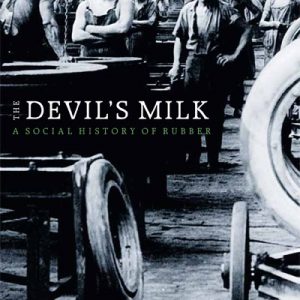John Tully: The Devil’s Milk: A Social History of Rubber
Monthly Review Press, New York, 2011. 468pp.
$24.95 pb, ISBN 9781583672310
Reviewed by Zach Sell
Zach Sell is a PhD student in History at the University of Illinois at Urbana-Champaign. His research examines the intersecting histories of U.S. slavery, British imperialism, and the Industrial Revolution.
Review
At the end of the nineteenth century, as wars for empire raged from the Philippines to South Africa, the French tyre company Michelin introduced Bidendum as its corporate symbol. The fat, white Michelin man fast became an internationally recognized symbol for the company. A century later, Bruno Peinado’s sculpture ‘The Big One World’ transformed the Michelin man into his opposite. The once white now brown Bidendum extends a clenched fist just beyond his Afro. His chest reads “The Big One World.” The sculpture recalls Paul Klee’s ‘Angelus Novus’; the image Walter Benjamin told us resembled the Angel of History, staring into the past and observing history as a single, unending catastrophe. Like ‘Angelus Novus’, Peinado’s Michelin Man stares back at the catastrophe of history, open-eyed, expressing awakening.
In The Devil’s Milk: A Social History of Rubber, John Tully gives life to the dynamic of catastrophe and awakening that defined rubber production. The Devil’s Milk reveals both the foundational violence of rubber production within capitalism and the lives of some of those who labored under, confronted, and resisted regimes of rubber production and extraction. At once a biography of rubber as a commodity and a history from below, The Devil’s Milk winds through histories of human and environmental devastation in Latin America, Asia, and Africa to factory production in the United States, England, and the concentration camps of Nazi Germany.
The Devil’s Milk begins with the transformation of rubber from a substance used in Mesoamerica into a commodity produced for and consumed within the capitalist world market. With the Industrial Revolution, Tully argues, “rubber’s potential began to be realized” (35). During the Industrial Revolution, the production of rubber and rubberized commodities converged with the production of textiles in Manchester. Dependent upon slave-produced cotton from the Southern United States, the textile industry in Manchester was the center of the Industrial Revolution. Covering textiles produced in Manchester in rubber, British industrialists produced not only rubberized raincoats but also Manchester sheeting that became central to industry. In addition to industrial production, the proliferation of rubber throughout Britain changed sexual practice. As Tully notes, the tactile sensation of rubber produced a sexual subculture surrounding Mackintosh coats and the vulcanized rubber condom further enabled sex for pleasure removed from reproduction.
Just as the explosion of rubber production transformed metropolitan imperial culture and industry, it devastated the so-called colonial peripheries of capital formation. Demand for rubber during the Industrial Revolution and throughout the nineteenth century was supplied through the extraction of wild rubber from South America, Africa, and Asia. For colonized populations exposed to regimes of rubber extraction, the impact was devastating. Tully demonstrates this in harrowing detail. Along the disputed borders between Peru and Columbia, the indigenous Huitoto were subjected to brutal violence during the wild rubber boom at the end of the nineteenth century. In the Congo Free State, King Leopold II relied upon a brutal regime of extraction that utilized forced labor and violence in the pursuit of profit.
Following the wild rubber boom, the collapse of prices in the 1890s caused the industrial supply of rubber to shift from wild extraction to plantation production in Malaya, Sumatra, Belgian Congo, and German East Africa. By 1913, plantations in Asia had outstripped wild rubber extraction in Brazil. The plantation industry, as Tully notes, “based upon cheap regimented labor and systematic cultivation under the supervision of experts,” outstripped wild rubber extraction and supplied the growing demand for rubber in Akron, Ohio, a center for tyre production, as well as globally (109).
The explosion of this growing demand was created by the mass production of automobiles following John Dunlop’s invention of the pneumatic tyre in the 1880s. This resituated rubber as integral to a burgeoning monopoly capitalism. Monopoly capitalism was further characterized by a solidification of the link between the plantation and the factory. Further, The Devil’s Milk reveals that this connection continued to extend beyond mere exchange. The systematically managed plantation and the scientifically managed factory became entwined. As Tully shows, the degradation of laborers in rubber factories in the United States through the brutal implementation of scientific management was at the same time dependent upon the implementation of regimes of colonial plantation production. Such a relationship is clearly presented through Firestone which operated both as a factory in Akron and as a plantation in Firestone, Liberia. Goodyear, Michelin & Dunlop established plantations globally as well….
Read the entire review in Marx and Philosophy Review of Books

Comments are closed.